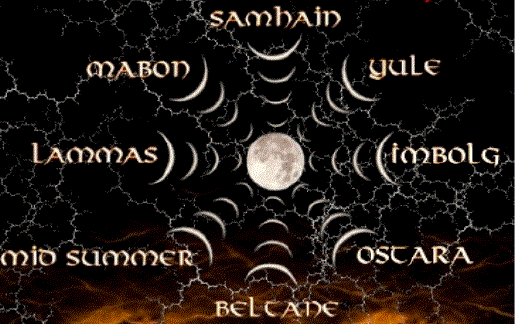|
|
|
 |
 |
 |
| First I will provide a list of Sabbats for adults. At the lower end of this page you will find a list of the same Sabbats in language for children to understand. |
|
| The Sabbats |
| The Sabbats tell us stories of the Goddess and God. |
|
| YULE |
|
| The Goddess gives birth to a son. The shortest day of the year. Watching the sun's rise is a good way to celebrating this day. The Sun is reborn again. Candles and fires are lit to celebrate the Sun's return. After this day the sun stays longer each day. Reminder that after death comes rebirth. |
| Detailed description of Yule |
|
|
| Ritual for Yule |
|
|
| IMBOLC |
|
| (Candlemas) The recovery of the Goddess after giving birth to the God. The God's power is felt in the longer days. Seed's germinate. And so the earliest beginnings of Spring occur. Sabbat of purification. Some female Witches follow the old Scandinavian custom of wearing crowns of lit candles. Initiations, self-dedications are performed and renewed. |
| Detailed description of Imbolc |
|
|
| Ritual for Imbolc |
|
|
| OSTARA |
|
| The Goddess blankets the Earth with fertility. The Vernal Equinox, also known as Spring. Days and night are equal in length. Light is overtaking darkness. Time of beginnings, action, planting seeds. |
| Detailed description of Ostara |
|
|
| Ritual for Ostara |
|
|
| BELTANE |
|
| The Goddess and God fall in love and unite. Fertility. Decorate your homes and self with flowers. The return of vitality, of passion and hopes consummated. |
| Detailed description of Beltane |
|
|
| Ritual for Beltane |
|
|
| MIDSUMMER |
|
| Summer Solstice when the earth is awash in the fertility of the Goddess and God. In the past bonfires were left to encourage fertility, purification, health and love. |
| Detailed description of Midsummer |
|
|
| Ritual for Midsummer |
|
|
| LAMMAS |
|
| Lughnasadh, the time of the first harvest. The God loses his strength as the Sun rises farther in the South each day and the nights grow longer. The Goddess watches in sorrow and joy as She realizes that the God is dying, yet lives on inside her as Her child. |
| Detailed description of Lammas |
|
|
| Ritual for Lammas |
|
|
| MABON |
|
| The completion of the Harvest begun. Day and night are equal and the God prepares to leave His physical body and begin the great adventure into the unseen. |
| Detailed description of Mabon |
|
|
| Ritual for Mabon |
|
|
| SAMHAIN |
|
| The Craft say farewell to the God. He begins to be reborn anew to the Goddess at Yule. Also known as Halloween. We remember those that have passed. |
|
| THE ESBATS |
| To each Lunar month the ancients assigned a name in accordance with the nature of the activity that took place at that time. |
|
| Wolf Moon The moon in deepest of Winter. In earlier times a time when the wolf came close to the villages to seek food. |
|
| Storm Moon The storms come in silence. They blanket the world in coldness. |
|
| Chaste Moon Like Diana, all of Nature at this moment is pure potential waiting to be fulfilled. |
|
| Hare Moon Rabbits leap and play carefree in their mating and joyful in their games. |
|
| Dyad Moon Sacred Marriage of the God and Goddess. When all meet their opposites in perfect balance and in perfect harmony. |
| Let there be beauty strength, power and compassion, honor and humility, mirth and reverence, within you." |
|
| Mead Moon After the bees have gathered their pollen and nectar the hives are filled with honey that is waiting to be gathered. |
|
| Wort Moon gathering of herbs, the word wort is old Anglo Saxon for "herb". |
|
| Barley Moon A time to contemplate the eternalness of life. The grain in the bread we eat are descended from the first grain ever gathered. |
|
| Wine Moon or Harvest Moon. A time of true spiritual initiation. Since wine was, and is, such a sacred fluid, the Pagans of old named this Lunar month the Wine Moon. |
|
| Blood Moon In days past a time for gathering food for the winter. The harvest supplemented by hunting wild animals or by slaughtering domestic ones. |
|
| Snow Moon Ahead are the dark months of winter. The Spirit is most active when the body is still. |
|
| Oak Moon The moon nearest the Winter Solstice. Like the Divine Child who is born to die and dies to be reborn anew, the ancient Oak has its trunk and branches in the material world of the living, while its roots, the branches in reverse, reach deep into the Underworld, symbolic land of the Spirit. |
|
| When? |
|
| Celebration Southern Hemisphere Northern Hemisphere |
| Winter Solstice 20-23 June 20-23 December |
| Candlemas 1st August 2nd February |
| Vernal Equinox 20-23 September 20-23 March |
| Beltaine 31st October 1st May |
| Summer Solstice 20-23rd December 20-23rd June |
| Lammas 2nd February 1st August |
| Autumnal Equinox 20-23 March 20-23rd September |
| Samhain 1st May 31st October |
| Blue Moon Comes but once a year *smile* The moon that occurs second in a one month period. |
| Detailed description of Samhain |
|
| Understanding Sabbats for Children: |
| Samhain/Halloween: (October 31) |
|
| This is the Wiccan New Year. This day marks the passing of the God We remember those who have died. They say that on this night the veil between the physical and spiritual worlds are thin. Some people leave a dish of food out for the souls of the dead. |
|
| Yule: (winter soltice) (December 21, or 22) |
|
| Here the Goddess gives birth to the God, and since his symbol is considered to be the Sun, it is also seen as the Sun being born. Berry candles are burned to ensure the next years wealth and happiness. Another pagan practice is the lighting of the Yule Log. This is a representation of of the rebirth of the God with in fire of the Mother Goddess. If you chose to burn a log, (it is usually of oak or pine). Carve or shalk a figure of the Sun, or the God (or a horned circle or a figure of a man) on it. As the log burns visualize the Sun shining within it and think of the coming warmer days. A piece of the log is saved to light the next years log. This piece is kept all year long for protection of the home. |
|
| Imbolc/Lupercalia: (February 2) |
|
| This is a time of purification's and light. It is traditional to light every lamp in the house, or candles in every room, at sunset or just after a ritual. Just to be sure not put the candles near any flammable objects and put them into a heat resistant container. If there is snow on the ground, walk in it for a while, thinking about the warmth of summer and spring. With your hand, trace an image of the Sun of the snow, and so bringing the Sun to earth. |
|
| Ostara (Spring Equinox): (March 21) |
|
| This day is the first day of Spring, and so the Goddess gives the earth her fertility, and the God grows to maturity. Here the Goddess is in her Maiden aspect. This time is for beginnings, to plant seeds, and practice forms of herbalism. Plan a walk through gardens, the woods, parks to grow an awareness for nature. |
|
| Beltane/May Day: (April 30) |
|
| Here the Goddess and the God , fall in love and, and lie among the grass and flowers, and the Goddess becomes pregnant. This begins the cycle of life, birth, and death. This Sabbat marks the return of life, of passion, of hope. Weaving is a traditional practice at this time of year. |
|
| Midsummer/Litha: (June 21) (Summer Solstice) |
|
| This marks the the highest point of the powers of nature. In the past, bonfires were leapt to have health, love, purification, and fertility. It is also said that faeries are most likely to be seen around this time, and in private woodlands and groves. Midsummer is a time for magic of all kinds. |
|
| Lammas/Lughnasadh: (August 1) |
|
| This day is the first harvest, when the plants drop their fruits or seeds for our use. The God loses his strength as the Sun rises farther in the South and the the nights grow longer. While the God is dying, the Goddess is joyful for he is also living inside her. Wheat weaving, such as the making of corn dollies, is a tradition as with visiting lakes, wells, fields, and orchards. |
|
| Mabon: (Autumn Equinox) (September 21) |
|
| This is the completion of the harvest that began at Lammas. Once again, day and night are equal, as the God is ready to leave His physical body. It is traditional to take a walk in wild places such as forests, and gather plants (always thank the earth when you collect something). |
 |



